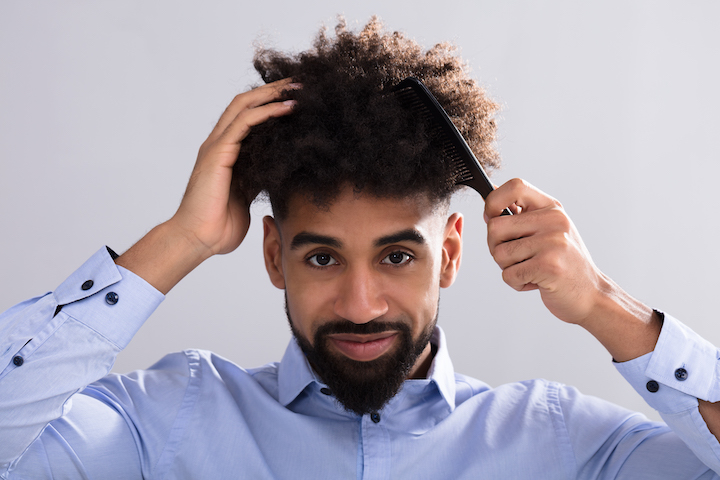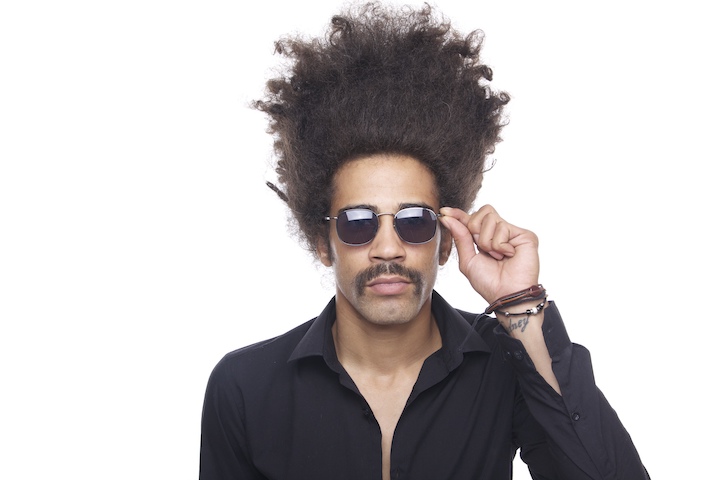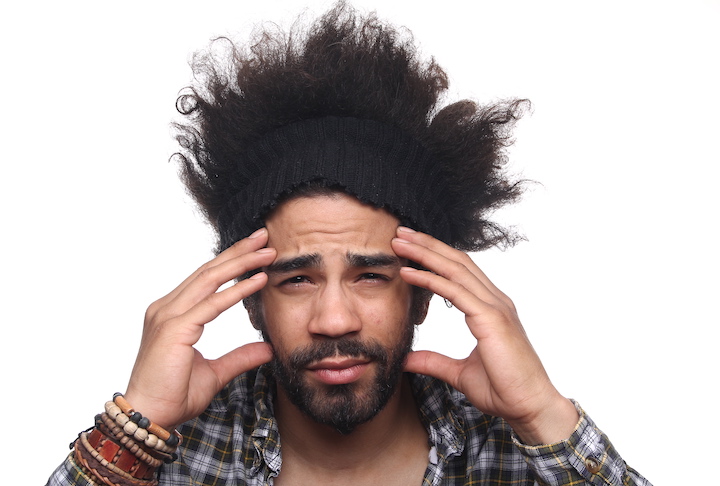If you don’t know what a conk hairstyle is, you can be excused because it is a term that has long been forgotten. The conk hairstyle was revolutionized by black men between the 1920s and 1960s. Instead of wearing natural hair, they opted to conk it or straighten it.
Today, you can rarely see a conk hairstyle, but they are still out there, and many of them can look good. If you can’t find a curly hairstyle that works for you, it may be time to think about conking it.
Table Of Contents
11 Most Popular Conk Hairstyles
We found a few excellent examples of this hairdo to help you realize how legendary a conk used to look. If you like what you see, you can opt for any protective hairstyle and perhaps create one yourself.
Side Part
A side part is usually something that you see with short hair. In this case, the situation is the same as the short conk hairstyle is split by a perfect side part. The hairstyle resembles something you would see in the 30s or 40s, but it is an exciting way to set your conk hair.
Pompadour
A pompadour style came to us straight from the 50s and was made popular when grease was invented and used to style your hair. The most iconic figure in sport is the King himself, Elvis Presley. In this case, after conking your hair, you only need some grease and pomp your hair as much as possible for a stylish old-school look.
Short With Laid Edges
A conk modern haircut can be created with a few ingenious styling moves made here or there. In this case, you can part the hair in the middle, push it back, but leave all the edges out. Only comb the top part and you are done. The only thing left to do is think of a facial hair style to add and if you decide to add one be sure to consider some expert-reviewed beard oils for proper maintenance.
Flat Top With Fade
Since the conk is about losing your curls and pushing your hair away from your face, the flat top fade is exactly what you need. Puff your hair with a comb, and use some hair gel and a hairdryer to set the hair as you wish. But to give it contrast, add a fade on the side of the head.
Comb Over With Skin Fade
This conk hairstyle requires you to fade out almost the entire part of the side of your head but never shave it completely. The other side should be kept longer, allowing you to make a comb-over. Be sure to push the hair up and away from the forehead.
Short Low Fade
The short, low fade is similar to the comb-over fade but is shorter. The top part of your head should be cut significantly closer to the scalp. The line between the top and the fade should be shaved down to provide contrast. You can look for some of the world’s best beard kits for black men to get a proper shave.
Caesar Cut With Soft Waves
Even though conk hair is meant to be straight, you can still give it a bit of texture. Do so by combing it up with the help of some premium wave brushes and adding a little bit of gel to get the waves going.
Quiff
A quiff is similar to the pomp, but it can be long and works best when you slick it or pull it back. You will need some product to make it stay, but we also suggest using shampoos designed for your hair type to help relax the hair.
Asymmetrical
The asymmetrical style where one part of the hair is set upwards while the other is combed downwards is a perfect love letter to the 80s. We were used to seeing many of these types of hairdos. Although they are a real rarity these days, many retro-style haircuts have made a triumphant return, and so can this one.
Slicked Back
A slicked-back conk hairstyle was something that many jazz musicians used to wear during the 20s. They did so until the 60s when natural hair started returning. Nevertheless, it is an iconic look and something that will live on for ages.
Spiked Up
The spiked-up conk style is perfect for the modern age. The relaxed hair can be pulled up and set in spikes but should coincide with the angles of your face. The sides of your hair should be shaven for a more masculine look. All that’s left is choosing one of the timeless beard styles for black men as an excellent addition to the spiked-up hairdo.
Short History
The conk hairstyle made its way among black men during the 20s. Most men either slick back the straightened hair or create a pompadour on the top. In either case, maintaining this look was exceptionally hard as the hair tended to revert to its natural state. So the only thing one could do was apply the product again or wear a do-rag at home to keep it set.
Nevertheless, many famous musicians of the age had various conk hairstyles. The style made it even to the 60s and you can see it on Muddy Waters’ album cover that came out in 1968, as he still sported one.
The style started fading towards the end of the 60s when Black Power and Black Pride movements began taking hold. The Afro and the Natural looks came back, leaving many conk hairstyles in the dust. But, there are still examples of black men having this style today, with the help of much safer and milder hair relaxers.
What Is Conk Hairstyle
The conk is derived from congolone, a hair straightening product made from lye. The conk hairstyle was made popular by black men between the 20s and 60s as they wanted to straighten their naturally kinky hair. They chemically straighten their hair and, in some cases, use the pure form of lye to do it.
The relaxer they used was sometimes made at home and involved a mixture of lye, potatoes, and eggs. Applying it required wearing gloves, and once doing so, you had to rinse your hair with water to avoid chemical burns.
Once straightening their kinks, men usually created either pompadour haircuts or slicked all the hair back, allowing it to stay flat on their heads. But the conk was a hairstyle that was immensely hard to maintain. Men had to wear some protection, like a do-rag, which would stop their hair from reverting to its natural state. Also, as new hair grew, one needed to constantly reapply the straightener and do the same to the newly grown hair.
A lot of older celebrity types were known for having a conk hairstyle. Some of them included James Brown, Louis Jordan, Chuck Berry, Little Richard, and the entire Temptations and the Miracles setup.
Today, the conk hairstyle is something that you rarely see. There are some new innovative ways to straighten your hair and different twists that people apply. But, if you are lucky enough, you can still spot a few of them here or there.
How to Get
Step 1 – Choose a good relaxer
A lye-relaxer was traditionally used back in the day. Still, you are better off with a calcium hydroxide relaxer for a sensitive scalp or an ammonium thioglycolate relaxer for fine hair.
Step 2 – Relax your hair
Ask a friend for help and avoid shampooing or combing your hair until the relaxer has set in and done its job.
Style 3 – Style your hair into a conk
Wash and condition your hair and dry it out. Decide on a style, comb it, and set it just how you like it.
Style 4 – Go for a beard choice
If you think your look is incomplete without some facial hair, go with some. Certain goatee styles for black men can be added here as well.
How to Maintain
Maintaining a conk hairstyle is a challenging piece of business. Once you straighten your hair, a lot of effort needs to be put in to make it stay still and not curl up again. This was one of the reasons men used to wear do-rags back in the day, as it would help them to keep their hair in place.
You need to be careful with the exposure to moisture, as the humidity can get it to curl back again in no time. While at home, you can place a hat or a scarf over your head to keep it from curling up.
Also, as the hair grows, it will regrow in its natural state, meaning more chemical relaxer needs to be reapplied to the parts that grow back. So if you think that you are not ready to apply a hair relaxer all the time, you should think about other hairstyle choices, as mohawks are an excellent option for black hair.
FAQ
Do people still conk their hair like they used to?
Actually, no. Back in the day, they used to do it with the help of a hair relaxer made of lye. Today, there are safer options that do not do as much damage to hair or skin.
Who invented the relaxer for black people’s hair?
Garrett Augustus Morgan was the person who first invented a hair relaxer for black men. He did so during the 1900s and later founded his own company G.A. Morgan Hair Refining Company, which specialized in creating this hair relaxer.
Does a relaxer damage the hair?
A relaxer works by penetrating the cuticle and the cortex layers of the hair, leaving it to lose its natural curl pattern. But it also makes the hair weaker and brittle and prone to breaking. It can even burn your skin and cause damage to your scalp if applied too much or too often.
Why are conks so sensitive to humidity?
When the hair dries out and loses its moisture, it starts to sap the air around it. Humid air can cause certain types of hair to blow out, especially the ones susceptible to dryness. In the case of natural hair, it can simply regain its curl and neutralize the effect of a hair straightening product.
Jay is one of the members of the Beardoholic writers team and NFL, celebrity barber. As a master barber with years of experience, Jay can make your beard look any way you envision. Jay’s specialty is black men’s hair and beard styles, but he also has deep knowledge on how to create a perfect neck and cheek line, short or long beard and virtually any beard and hair shape and style.



